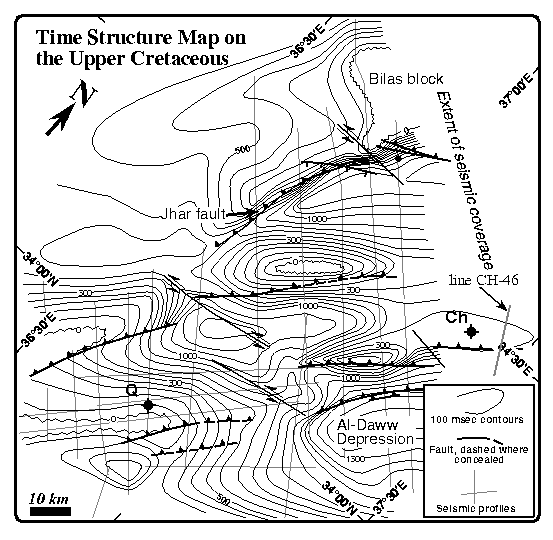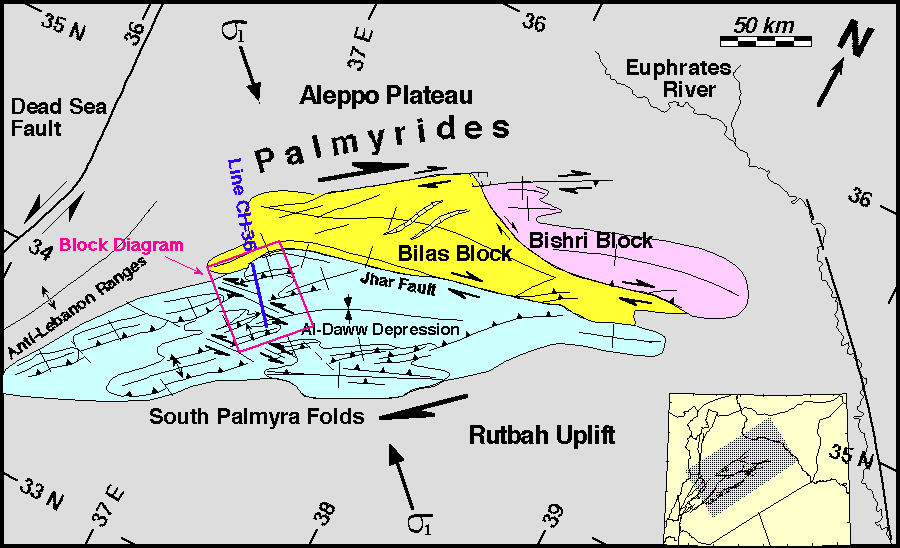Home | Results Summary | Publications | Participants | M.East / N.Africa Home
![]()
The Palmyride fold belt, a 400 X 100 km transpressive belt in central Syria that is the northeastern arm of the Syrian Arc, which includes the Negev fold belt in the Sinai, is the result of Late Mesozoic and Cenozoic inversion of a Late Paleozoic and Mesozoic, NE-trending, linear intracontinental basin located within the northern Arabian platform. The southwestern Palmyrides, near the Dead Sea transform fault system and the Anti-Lebanon mountains, are characterized by short wavelength (5-10 km) en echelon folds separated by small intermontane basins that developed mainly in Neogene to Recent times. A new three-dimensional data cube, 60 X 70 km, generated on a Landmark Graphics(TM) workstation and based on approximately 700 km of two-dimensional seismic reflection profiles, elucidates the structure of the upper 10 km of the crust in the southwestern Palmyrides. Visualization of the subsurface structure, which is represented by a prominent Upper Cretaceous reflection surface in the data cube, is augmented by the topography and Bouguer gravity of the same region. Preexisting discontinuities, probable normal fault relicts of the Mesozoic Palmyride rift, likely controlled the development of individual Neogene thrusts. The new subsurface image shows important structural features not identified in outcrop. Short, WNW-trending transcurrent, or transfer, faults link the short, en echelon NE-trending thrust faults and blind thrusts of the Palmyrides. A pervasive regional décollement is not observed, even though Triassic evaporites host local detachments. There has been no wholesale transport of shallower strata on a regional décollement that decouples Mesozoic and Cenozoic rocks from underlying Paleozoic rocks.
Unlike topographic relief, which only roughly resembles subsurface structures, the Bouguer gravity signature of the southwestern Palmyrides closely mimics underlying shallow geologic structures both on a large (~50 km wavelength) and a small (~5-10 km) scale. Relatively uncommon reflections from deformed Paleozoic rocks and the excellent correlation between Bouguer gravity and shallow structures indicate a general concordance between shallow Mesozoic and Cenozoic rocks and deeper Paleozoic rocks. Hence, Paleozoic rocks either deformed together with shallower strata, or structures within Paleozoic rocks controlled the development of shallower Neogene and younger structures.
Our structural analysis and many other recent studies of the region are indicative of minor right-lateral shear coupled with compression in the Palmyrides.
Figure 1. Map of a portion of the southwestern Palmyrides showing subsurface structure of the Upper Cretaceous unconformity discussed in text as interpreted on a Landmark(TM) workstation, locations of all seismic reflection profiles used in the study, and important features mentioned in text. Detailed structural interpretation is based on some 20 industry seismic reflection profiles shown by the shaded lines. Ch: Cheriffe well; Q: Qariatein well.

Figure 2. Block diagrams schematically illustrating inversion of southwestern Palmyrides from Mesozoic rift (top) to Cenozoic fold belt (bottom). Mesozoic rift fault geometries are drawn based on the geometry of present-day thrust faults. Note the reversal of strike-slip sense across the transfer faults.

Figure 3. Simplified kinematics of the Palmyrides, with emphasis on known senses of strike-slip component across major fault zones. Proportion of strike-slip vs. compression are not known; however, compression most likely dominates.

Figure 4. Regional kinematic diagram of the northern Arabian platform. Right-lateral sense of shear in the Palmyrides requires the extrusion of the Aleppo plateau towards the northeast. Fault arrow sizes are approximately proportional to the amount of slip along fault zones. A local pivot point between the Aleppo plateau and Rutbah uplift is inferred to lie near the Palmyride-Euphrates intersection (inset). The Euphrates fault system may decouple deformation west of the Euphrates (Palmyrides) from that to the east (Sinjar).

Go back to Summary of Results
Go back to Cornell Syria Project Welcome Page